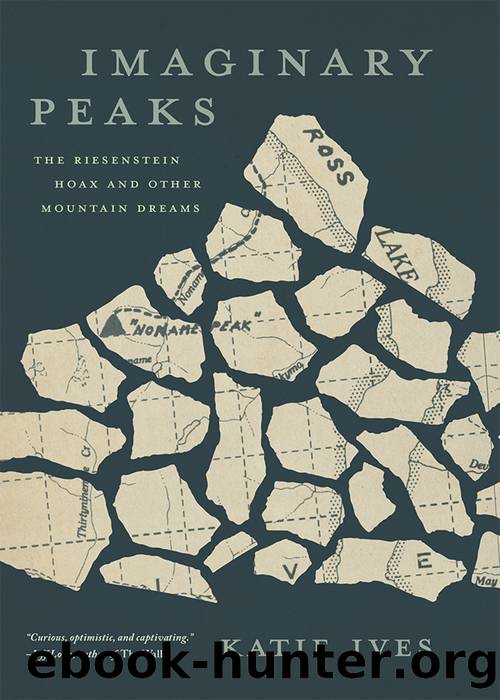Imaginary Peaks: The Riesenstein Hoax and Other Mountain Dreams by Katie Ives

Author:Katie Ives [Ives, Katie]
Language: eng
Format: epub
Tags: history, Expeditions & Discoveries, Sports & Recreation, Mountaineering, Social Science, Folklore & Mythology
ISBN: 9781594859816
Google: EQ88EAAAQBAJ
Publisher: Mountaineers Books
Published: 2021-10-01T23:43:14.708776+00:00
HARVEY MANNING PONDERED THE RIVALRY OF PEARY AND COOK AGAIN and again in his writings. Parts of the story overlapped with his own childhood. As a boy, Harvey had mowed the lawn of a neighbor, Joe Quigley, a famous prospector, who showed him a sample of Alaskan wire gold and told him a story about sitting in a bar in Fairbanks with other miners when the Sourdoughs hatched their plan to prove Cook wrong. When Harveyâs uncle asked Joe why he didnât join them, Joe responded, âWasnât drunk enough.â
In many ways, Harveyâs hoaxes were the opposite of Cookâs. Instead of claiming a false record, Harveyâs imaginary climbers told stories in which they failed to reach their ultimate goals. They tempted their readers to try to make the first ascents themselves. These narratives fit Harveyâs aim of pointing out the absurdity and inappropriateness of climbing mountains for personal glory in the first place. Yet Harvey also wondered why so many people believed Pearyâs word instead of Cookâs, when it was possible that both men might be hoaxers. âThe 1906 Cook climb is not accepted because the Establishment (Peary-National Geographic Society-U.S. Navy-Brad Washburn) ganged up on Outsider Cook,â Harvey decided.
There was much about Cookâs life to make him a sympathetic character in Harveyâs mind. Like Harvey, Cook had struggled to find a place for himself in a world of adventurers from more privileged backgrounds. Both menâs writings, true or false, testify to an opulent imagination and a keen ability to create detailed fantasy worlds. By the 1960s, as biographer Robert M. Bryce has pointed out, Cook had become a kind of âantiestablishmentâ hero (or antihero) in the minds of readers skeptical of all authorities. Cookâs own words, taken out of context, could provide an attractive defense for future hoaxers: âThe world has important use for dreamers, even if they fail.â
Over the decades after Cookâs tale, Denali seemed to transform from the otherworldly mountain of his writings into a commercial playground. âWhat made Denali not merely a super-Blanc but a whole other species,â Harvey wrote in âMount Everest and Me,â âwas the sledging over the snows to the start of the climb and the fording of thawed-out and meltwater-raging rivers on the way back. The airplane cut it down to size, a wilderness grizzly shrunk to a playroom teddy.â Whether or not Cook summited, the landscapes of his epic adventures were vanishing into thin air as surely as the snows of Fake Peak. Harvey could only gaze backward in time through books at a lost world that receded ever farther from his graspâexcept, that is, when he re-created it by doctoring the maps.
Other aspects of Cook and Pearyâs rivalry fascinated Harvey as well. The North Pole was a kind of ultra-imaginary place, as Bryce has observed, âa point with no dimensions . . . where every direction is south.â Time seems unhinged by twenty-four-hour summer light. The very idea of claiming a specific point on this terrain is meaningless. Nothing permanent exists within its shifting heaps and ridges of ice.
Download
This site does not store any files on its server. We only index and link to content provided by other sites. Please contact the content providers to delete copyright contents if any and email us, we'll remove relevant links or contents immediately.
| Africa | Americas |
| Arctic & Antarctica | Asia |
| Australia & Oceania | Europe |
| Middle East | Russia |
| United States | World |
| Ancient Civilizations | Military |
| Historical Study & Educational Resources |
Machine Learning at Scale with H2O by Gregory Keys | David Whiting(4190)
Never by Ken Follett(3796)
Fairy Tale by Stephen King(3220)
The Man Who Died Twice by Richard Osman(2997)
Oathbringer (The Stormlight Archive, Book 3) by Brandon Sanderson(2891)
Will by Will Smith(2794)
Rationality by Steven Pinker(2291)
The Dark Hours by Michael Connelly(2246)
Can't Hurt Me: Master Your Mind and Defy the Odds - Clean Edition by David Goggins(2229)
The Dawn of Everything: A New History of Humanity by David Graeber & David Wengrow(2123)
Friends, Lovers, and the Big Terrible Thing by Matthew Perry(2123)
Principles for Dealing With the Changing World Order: Why Nations Succeed and Fail by Ray Dalio(1974)
HBR's 10 Must Reads 2022 by Harvard Business Review(1778)
A Short History of War by Jeremy Black(1763)
Go Tell the Bees That I Am Gone by Diana Gabaldon(1687)
515945210 by Unknown(1601)
A Game of Thrones (The Illustrated Edition) by George R. R. Martin(1591)
Kingdom of Ash by Maas Sarah J(1529)
443319537 by Unknown(1470)
